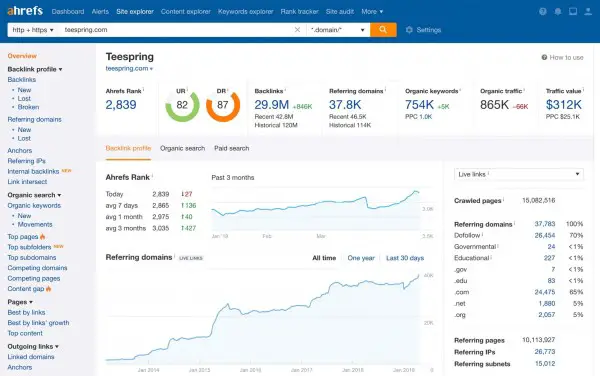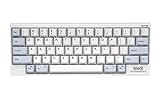Investing $500 Into Your New Blog
Investing in Blogging is not something you hear about very much; it's actually quite hard to gauge how much of a return you're going to get back on your money because you don't know how well your blog is going to do. When starting a new blog, investing money into it can be even trickier as you have to wait for Google to start indexing your site. This article will take a look at all the ways you can invest money into a new blog and see how much of an effect it can have on traffic, rankings and earnings.

- Investing Into A New Blog
- Investing In Blog Content
- Investing In the Blogging Basics
- Investing In SEO Tools
- Investing in Ads and Paid Traffic
- Investing In Backlinks
- Conclusion: New Blogs Are New
Investing Into A New Blog
Starting a new blog can feel exciting, daunting and sometimes even boring. Blogging has so many different elements to it that someone who is new to blogging can find them a little overwhelming. There is money to be made, and that means you're going to be competing against thousands and thousands of people. Can you offer something unique that will make your blog stand out from the crowd?
Investing money into a blog is one way you can help boost your blog's progression. If you have money to spare, it certainly is a lot easier starting a new blog as opposed to doing everything from scratch.
Let's assume you have $500.00 to invest into a new blog; what exactly can you get for that kind of money?
Investing In Blog Content
Blog content is arguably the most valuable part of your blog. It's what attracts traffic, keeps returning visitors and makes your blog worthwhile. If you haven't heard this saying yet, you're definitely a beginner:
Content Is King
There are bloggers who absolutely hate writing content and most of their content is outsourced. Producing thousands and thousands of words a month is enough to give any blogger burnout; it's almost like writing a book, only you can jump to various topics that interest you.
Outsourcing content is one of the best ways to invest in your blog. You'll need to hire freelance writers, all of which will have a different rate. There are quite a few bloggers who will hire super cheap writers from places like Fiverr, a place where you can get 500 words for $5. But a lot of the time you get what you pay for, and a $5 article isn't going to have the best written content compared to if you hired someone for $50 for 500 words.
A $500 investing budget isn't actually a lot when it comes to content. The big bloggers are paying that amount and more every single week. The reason: because they are making so much money from those articles that they can afford to. High quality content will attract a lot of traffic naturally and high traffic equals cash from ads.
As a new blogger, you have to consider that any content you write on your blog needs to take time to mature. This is called the Google Sandbox Effect.
The Google Sandbox Effect is a period in which a site doesn't gain any traction on the Google Search Pages because it is new. Google puts sites into the sandbox, where they must dwell for 6-12months before Google starts ranking their content.
That means even if you buy high-quality content for your new blog, it's going to take a while for it to rank. The good news is that once your blog is out of the sandbox, your content gets ranked much quicker and higher.
Of course, Google isn't the only source of traffic for high-quality content. A lot of traffic can be obtained from social media sites, like Pinterest, Twitter and Facebook. Sharing high-quality content on these sites is one way to get traffic; though it is usually seen in spikes and never lasts compared to Google Traffic.
The return on investment for your content is also subject to how competitive your niche is. Writing premium content does not guarantee you traffic; if there are ten other big bloggers writing the same article, your article is likely going to struggle to gain any traffic due to those big bloggers being established. This is where SEO and Keyword Research comes in. By identifying low competition keywords, you can come up with a list of articles to have written that will be able to rank more easily.
There are of course other types of content you can invest in, including video content, which is extremely popular. Having YouTube vidoes can help generate traffic to your blog as well as give you another outlet for content. If you don't have any video recording software and want to make the videos yourself, you'll need to invest in some software such as Adobe Premier Pro. Or look to hire someone to make video content for you. Video content tends to be ten times more expensive than written content though.
Overall, investing in content is one of the best ways to improve your blog, especially if you're not enthusiastic about producing your own. The return on investment is variable though and can take a lot of time to see any money back.
Investing In the Blogging Basics
To start a blog, you'll want to have the basics covered first.
This includes getting a paid web-host like Bluehost and your own domain name (Bluehost offers a free one with signups!). A domain name and paid for hosting shows you're serious about your blog. Using a free blog platform like Wordpress.com or Blogger.com usually never do well compared to being your own webmaster.
Luckily, web-hosting and domain names are extremely cheap. Shared hosting tends to cost less than $5/month and a domain name will cost you around $10/year.
These basic essentails can be upgraded too; you could spend even more money on a better, more powerful webhost but the chances of you needing that are unlikely. A new blog isn't going to get much traffic (unless you're extremely lucky!) and so spending $20-$30/month on a better webhost is a waste.
You can also buy a more premium domain; there are several auction sites that will sell off more desirable domain names that can cost up to thousands and thousands. Why do people pay this much for these domains? Well there is a few reasons:
- Old domains or expired domains have backlinks which are worth money; backlinks help make a site seem more trustworthy to Google so people will bid high on these domains so that they can rank in Google searches higher
- Branding - if a domain name is taken for your particular brand, you might be able to purchase it off someone for a higher price. For a new blogger, this usually isn't worth it, but if you're a business, it makes more sense.
You may also find investing into a new blog theme/design is worth doing it. Today, you can pick up professionally made themes for WordPress blogs for as low $40. These themes have many customisable tools to make them unique to your own blogging site. It can help make your blog look like the real deal.
Overall, a cheap simple web host with a good reputation and a simple .com domain name should be fine for a new blogger.
Investing In SEO Tools
SEO is all about optimising your new blog so that the articles you write actually rank in Google and bring you traffic. We've already talked about the Google Sandbox, but you can also boost your site rankings with SEO. These tips and tricks help you outrank your competitiors, and it's something that some people have made a career out of.
If you're interested in the SEO side of blogging, there are various paid-for tools you can use to give you an advantage over your competitors.
Some useful tools are:
- SERP Ranking Tracker - These types of tools check what position your articles are ranking in Google for specific keywords. For example, you could check the keyword Blogging in google, and see how far your down the list your article ranks. This is a great way to track whether changes you're making to your site are helping to increase ranks. It can also help explain when you gain a sudden amount of traffic (or lose a sudden amount!)
- Keyword Analysis Tools - These types of tools help you identify keywords which might be worth writing articles about. They have many different features, such as checking out the competition for keywords, giving you suggestions for low competition and also analysing backlinks that will help you rank for them.
- Site Profile Tools - These tools will analyse a site that you're interested in. They usually look at how many backlinks the site has and try to guess what their most ranked artices are. This can give you ideas on how to obtain links, what articles to target and more.
- Backlink Research - Links are the most important metric when it comes to ranking a site, and these tools aim to find all the links that a site has. It allows you to see where your competition is getting links from so you can too.
Now there are a lot of paid-for tools out there. All of them have different price points and a lot of them are quite expensive for new bloggers.

The best SEO tool is Ahrefs. But at a mouth-watering $99/month for the lite-version, it's extremely expensive. Ahrefs offers you everything you could ever need from a SEO tool and it provides the best data compared to all other tools out there.
Some less expensive ones include KWFinder. This costs around $40/month and offers some of the best interfaces for finding keywords to write about.
If you're stuck for content ideas and are not really sure what content will be best for your blog, investing in a months use for these tools can help you generate a mass of ideas. Casual bloggers will often only use these tools a couple of times a week, and that is not worth paying for them every month. It is best to have a plan of action, pay for a month's use and then get as much data as you possibly can.
Investing in Ads and Paid Traffic
One way to get instant traffic to any new blog is by buying traffic. You can sign up to Google Adsense right away and create adverts for your site. They'll then be displayed in the Google Search alongside organic listings and you'll be able to get traffic that way.
The cost of adverts though is extremely high. Paying for traffic should only be considered when you have a way to monetize that traffic; whether you have a service to offer, email list, affiliate program or any of those methods to help generate revenue. You'll then need to test to make sure the ads give you a ROI (return on investment). If you buy $500 worth of ads, how much money did you make back? If the answer is close to zero, it's usually not worth buying traffic for your blog just yet.
Ad traffic is temporary. It doesn't really do much to your site if you have no way to capitalise on it. Buying ads is whole other game and there are professionals who have made a career out of it; trying to get the best rates for certain keywords, testing landing pages and optimising conversions. For a new blogger, I would stay well away from this.
Investing In Backlinks
This is a controversial topic when it comes to investing in your new blog. Google loves links; it's how they determine who gets ranked at the top of their search results. The more links a site has, the more authority Google gives that site. Thus, there are people who buy and sell links.
The problem with this is that Google have said buying links is against their Terms and Conditions and that they will penalise sites who do it. How they can detect this is up for discussion, but a lot of bloggers will steer away from this murky area.
Buying links doesn't have to be the only way to "invest" in backlinking. You can also invest in spending time looking for fellow bloggers who will want you to Guest Post for them. You can offer to write a post for their blog in exchange for linking back to your site.
Getting creative with how you acquire links is another part of the SEO game and it's something worth considering if you're a serious blogger.
New Blogs Are New
I think the final thought for this article is that a new blog should be treated like a new blog. And by that I mean you need to have patience. You need to work hard and be OK with not having any results for months and months. That is what almost all bloggers go through at the beginning and those that survive end up reaping the rewards.
Investing can help in certain areas and definitely is something to consider if you have a budget to spend. But like with any investment, it requires careful planning and strategy to make sure you get that money back and more so.
If you have any strategies for investing in your blog, let us know in the comments!
















Leave A Comment